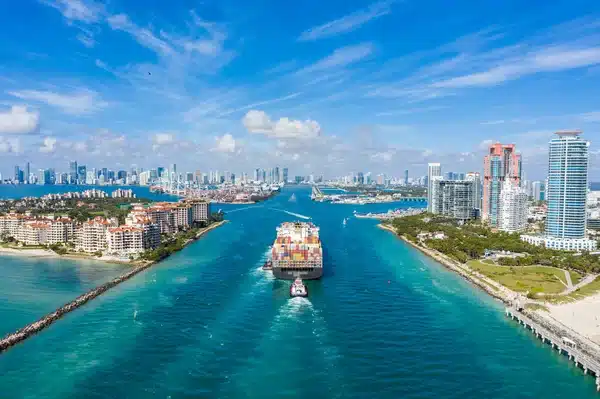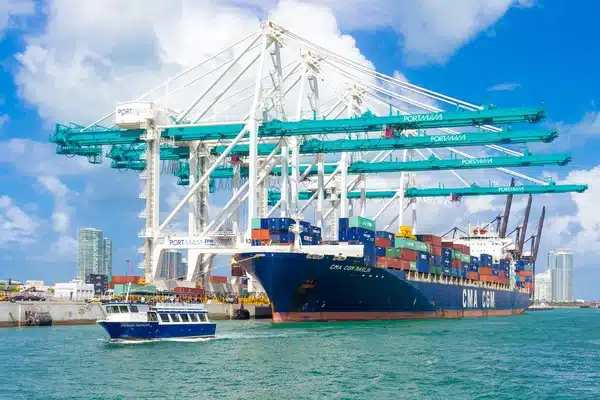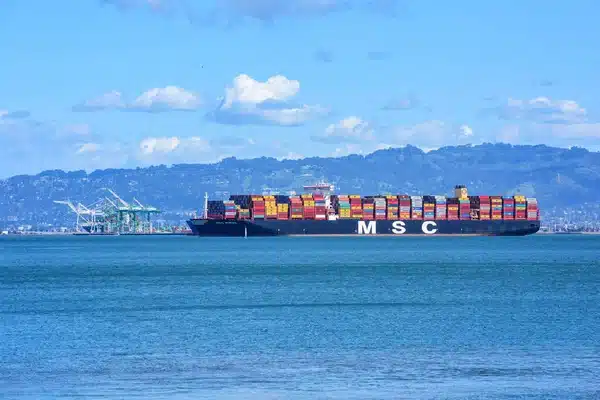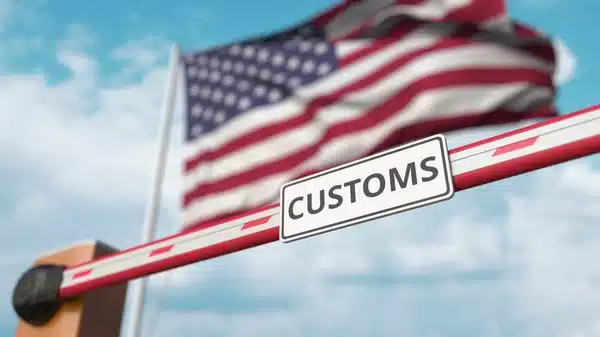Sea freight shipping remains the backbone of international trade between China and the USA. With the massive volume of goods traded daily, understanding the intricacies of sea freight is crucial for businesses looking to optimize costs and streamline logistics.
In this comprehensive guide, we will cover the key aspects of sea freight shipping, including container options, transit times, shipping costs, customs clearance, and best practices to ensure a hassle-free experience. Whether you’re a seasoned importer or new to global trade, this article will equip you with actionable insights.

Table of Contents
Major Ports for Shipping from China to the USA
Choosing the right ports for shipping from China to the USA is crucial for optimizing costs, transit times, and logistics efficiency. Here’s a guide to the major departure and arrival ports involved in China-USA trade.
Departure Ports in China
China has several major ports that serve as key gateways for exports to the USA. Below are some of the most prominent options:
| Port | Location | Advantages |
|---|---|---|
| Shanghai Port | Eastern China | World’s busiest container port, offers frequent sailings and diverse shipping routes. |
| Ningbo-Zhoushan Port | Zhejiang Province | Handles high volumes of containerized cargo, ideal for large-scale shipments. |
| Shenzhen Port | Southern China | Major hub for electronics exports, close to manufacturing centers in Guangdong. |
| Guangzhou Port | Southern China | Flexible options for both LCL and FCL shipments, with excellent inland connections. |
| Qingdao Port | Northern China | Serves Northern China’s industrial regions; efficient handling of diverse cargo. |
| Tianjin Port | Beijing Area | Key port for exports from northern China, excellent rail connectivity. |
| Hong Kong Port | Special Administrative Region | Offers flexibility with international shipping options and high-frequency sailings. |
Arrival Ports in the USA
The USA has numerous ports along its East Coast, West Coast, and Gulf Coast to accommodate imports from China. Here are the major destination ports:
| Port | Location | Advantages |
|---|---|---|
| Los Angeles Port | California (West Coast) | Handles the largest volume of imports from Asia, ideal for high-capacity shipments. |
| Long Beach Port | California (West Coast) | Known for its efficiency and proximity to Los Angeles, great for retail goods. |
| New York/New Jersey Port | New York (East Coast) | Key hub for imports destined for the Eastern USA, excellent rail connections. |
| Savannah Port | Georgia (East Coast) | Fast-growing port with efficient operations, serves the Southeast USA. |
| Houston Port | Texas (Gulf Coast) | Ideal for goods destined for the central and southern USA. |
| Seattle-Tacoma Port | Washington (West Coast) | Alternative to LA/Long Beach, known for shorter wait times. |
| Miami Port | Florida (East Coast) | Serves the Southeast and Latin America connections. |
Factors to Consider When Choosing Ports
- Proximity to Destination: Select arrival ports closer to your end destination to reduce inland transportation costs.
- Type of Goods: Ports with specialized facilities may be required for certain types of cargo (e.g., refrigerated goods).
- Shipping Costs: Larger ports typically offer competitive rates due to high cargo volumes.
- Transit Time: West Coast ports (e.g., Los Angeles, Long Beach) offer faster transit times for shipments from China.
- Customs Efficiency: Choose ports with streamlined customs procedures to avoid delays.

Best Shipping Routes for Containers from China to the USA
Choosing the optimal shipping route for containers from China to the USA involves balancing factors such as cost, transit time, and final destination. Below are the most common and efficient routes categorized by the region of departure in China and destination in the USA.
Routes from China’s East Coast Ports to the USA
Departure Ports: Shanghai, Ningbo, Qingdao
Destination Ports on the West Coast: Los Angeles, Long Beach, Seattle-Tacoma
- Route: Pacific Ocean direct shipping route.
- Transit Time: 15–20 days.
- Best For: Faster delivery for goods bound for West Coast states.
Destination Ports on the East Coast: New York/New Jersey, Savannah, Charleston
- Route: Via the Panama Canal or intermodal rail after West Coast unloading.
- Transit Time: 25–35 days.
- Best For: Cost-effective delivery for goods intended for Eastern or Midwestern states.
Routes from China’s South Coast Ports to the USA
Departure Ports: Shenzhen, Guangzhou, Hong Kong
Destination Ports on the West Coast: Los Angeles, Long Beach
- Route: Direct across the Pacific Ocean.
- Transit Time: 12–16 days.
- Best For: Electronics and consumer goods from Guangdong’s manufacturing hub.
Destination Ports on the Gulf Coast: Houston, New Orleans
- Route: Pacific Ocean to the Panama Canal, then the Gulf of Mexico.
- Transit Time: 25–30 days.
- Best For: Goods intended for the Southern and Central USA.
Routes from China’s North Coast Ports to the USA
Departure Ports: Tianjin, Dalian, Qingdao
Destination Ports on the West Coast: Seattle, Oakland
- Route: Direct via the North Pacific Ocean.
- Transit Time: 18–22 days.
- Best For: Machinery and industrial goods from northern China.
Destination Ports on the East Coast: New York/New Jersey, Savannah
- Route: Through the Panama Canal or via transshipment in Canada (Prince Rupert or Vancouver).
- Transit Time: 30–40 days.
- Best For: Lower-cost shipping for bulk goods.
Specialized Routes
Fast Shipping with Transpacific Services
- Departure Ports: All major ports (Shanghai, Shenzhen, Hong Kong)
- Destination Ports: Los Angeles, Long Beach
- Transit Time: 10–12 days (express services).
- Best For: High-priority shipments that need expedited delivery.
Northern Route through Canada
- Departure Ports: Qingdao, Dalian
- Transshipment Ports: Prince Rupert, Vancouver (Canada)
- Final Destination: East Coast ports like New York or Baltimore via rail.
- Best For: Reducing congestion at West Coast USA ports.
Factors to Consider When Choosing a Route
- Destination Proximity: Choose West Coast ports for goods destined for California or nearby states and East Coast ports for the Midwest and beyond.
- Shipping Costs: Direct routes are typically cheaper, but intermodal routes (sea+rail) may save on inland delivery costs.
- Type of Goods: Perishable goods benefit from faster West Coast routes, while non-perishables can use slower, cheaper routes.
- Seasonality: Peak shipping seasons may increase congestion on popular routes.
Shipping Schedule from China to United States Ports
The shipping schedule from China to the United States varies based on the port of origin, the destination port, and the chosen shipping method. Below is a typical shipping schedule for major sea freight routes between the two countries.
West Coast Ports (Fastest Transit Times)
| Origin Port in China | Destination Port in USA | Transit Time | Frequency |
|---|---|---|---|
| Shanghai | Los Angeles | 12–15 days | Weekly sailings |
| Ningbo | Long Beach | 14–18 days | Weekly sailings |
| Shenzhen | Seattle | 16–20 days | Bi-weekly sailings |
| Guangzhou | Oakland | 15–19 days | Weekly sailings |
East Coast Ports (Longer Transit Times)
| Origin Port in China | Destination Port in USA | Transit Time | Frequency |
|---|---|---|---|
| Shanghai | New York | 25–30 days | Weekly sailings |
| Ningbo | Savannah | 28–35 days | Bi-weekly sailings |
| Shenzhen | Charleston | 30–37 days | Weekly sailings |
| Guangzhou | Miami | 32–38 days | Weekly sailings |
Gulf Coast Ports
| Origin Port in China | Destination Port in USA | Transit Time | Frequency |
|---|---|---|---|
| Shanghai | Houston | 28–32 days | Weekly sailings |
| Ningbo | New Orleans | 30–35 days | Weekly sailings |
| Shenzhen | Houston | 32–37 days | Bi-weekly sailings |
Factors Influencing Shipping Schedules
- Seasonality: Peak seasons (e.g., before Chinese New Year or the holiday season) may extend transit times due to port congestion.
- Route Choices: Direct routes are faster, while transshipment (via Singapore or Panama) can add days to the schedule.
- Shipping Line: Different carriers may have varying frequencies and schedules.
Sea freight is one of the most cost-effective and widely used shipping methods for transporting goods from China to the USA. With well-established trade routes and advanced port facilities on both sides, it provides a reliable solution for businesses looking to ship large volumes of cargo. Whether you are shipping full container loads (FCL) or smaller volumes (LCL), sea freight offers flexibility and efficiency.
China’s major ports, such as Shanghai, Ningbo, Shenzhen, and Guangzhou, connect to key ports in the USA, including Los Angeles, New York, and Houston, ensuring seamless international trade. This method is ideal for industries such as electronics, furniture, textiles, and machinery due to its capacity to handle bulk goods at economical rates.
For businesses aiming to balance cost and delivery timelines, sea freight remains a preferred choice. With multiple routes and frequent sailings, it caters to a wide range of shipping needs, making it an essential link in global supply chains.

Shipping Cost from China to the USA
The cost of shipping from China to the USA varies based on the shipping method, cargo type, container size, and destination. Below is an overview of the typical costs for sea freight.
Here is the updated shipping cost table for March 2025:
| Origin Port | Ocean Freight Rates from China to USA |
|---|---|
| How much does it cost to ship a container from Shanghai China to USA | 20 foot container FCL: Average price from $1650 20FT 40 foot container FCL: Average price from $2050 40FT |
| How much does it cost to ship a container from Shenzhen China to USA | 20 foot container FCL: Average price from $1200 20FT 40 foot container FCL: Average price from $1850 40FT |
| How much does it cost to ship a container from Ningbo-Zhoushan China to USA | 20 foot container FCL: Average price from $1550 20FT 40 foot container FCL: Average price from $1950 40FT |
| How much does it cost to ship a container from Hong Kong China to USA | 20 foot container FCL: Average price from $1850 20FT 40 foot container FCL: Average price from $2850 40FT |
| How much does it cost to ship a container from Guangzhou China to USA | 20 foot container FCL: Average price from $1750 20FT 40 foot container FCL: Average price from $2750 40FT |
| How much does it cost to ship a container from Qingdao China to USA | 20 foot container FCL: Average price from $1750 20FT 40 foot container FCL: Average price from $2750 40FT |
| How much does it cost to ship a container from Tianjin China to USA | 20 foot container FCL: Average price from $1650 20FT 40 foot container FCL: Average price from $2850 40FT |
| How much does it cost to ship a container from Dalian China to USA | 20 foot container FCL: Average price from $1500 20FT 40 foot container FCL: Average price from $1950 40FT |
| How much does it cost to ship a container from Xiamen China to USA | 20 foot container FCL: Average price from $1650 20FT 40 foot container FCL: Average price from $1950 40FT |
| How much does it cost to ship a container from Yingkou China to USA | 20 foot container FCL: Average price from $1500 20FT 40 foot container FCL: Average price from $1950 40FT |
Factors Influencing Costs
- Shipping Method: Air freight costs more than sea freight but offers faster transit times.
- Container Size: FCL shipments (20ft/40ft containers) cost less per unit than LCL.
- Destination Port/City: Costs increase for East Coast or Gulf Coast destinations due to longer transit times.
- Cargo Type: Special handling for fragile or hazardous goods can increase costs.
- Seasonality: Peak seasons (e.g., before holidays) see higher freight rates due to demand.
Customs clearance and tax rates for goods from China to the United States
When importing goods from China to the United States, it is crucial to understand the customs clearance process and the applicable tax rates. Here’s a detailed guide:

Customs Clearance Process
The customs clearance process ensures that all imported goods comply with U.S. regulations and that the appropriate duties and taxes are collected.
Steps in the Process:
Preparation of Documentation:
- Commercial Invoice: Includes details of the transaction, such as the value of goods, description, and origin.
- Bill of Lading (BOL): Proof of shipment, issued by the carrier.
- Packing List: Details of the cargo, including dimensions and weight.
- Certificate of Origin: Specifies the country where the goods were manufactured.
- Import Licenses (if applicable): Required for certain restricted or regulated items.
Entry Filing:
- The importer or customs broker files an Entry Summary (CBP Form 7501) with U.S. Customs and Border Protection (CBP).
- An Importer Security Filing (ISF) must also be submitted for ocean shipments.
Customs Inspection:
- CBP may inspect shipments for compliance with safety, quality, and legal standards.
- Goods subject to inspection include electronics, textiles, and food products.
Payment of Duties and Taxes:
- Duties and taxes must be paid before goods are released to the importer.
Release of Goods:
- Once all requirements are met, goods are cleared for delivery.
Tax and Duty Rates
Customs Duties:
- The duty rate depends on the Harmonized Tariff Schedule (HTS) code assigned to the goods.
- Rates range from 0% to 37.5%, with most products falling between 5% and 15%.
- Some goods, like certain electronics, may be duty-free.
Section 301 Tariffs:
- Additional tariffs (up to 25%) may apply to goods from China due to ongoing trade regulations.
Merchandise Processing Fee (MPF):
- For formal entries (valued over $2,500): 0.3464% of the value of goods, with a minimum of $29 and a maximum of $556.
- For informal entries: $2–$9.
Harbor Maintenance Fee (HMF):
- 0.125% of the value of goods for shipments arriving via ocean freight.
State Taxes:
- Some states may impose additional taxes depending on the final delivery location.
Exemptions and Special Cases
- De Minimis Value: Goods valued under $800 per shipment are exempt from duties and taxes under Section 321 of the Trade Facilitation and Trade Enforcement Act.
- Free Trade Agreements (FTAs): Some goods may qualify for reduced or zero duties under specific agreements (e.g., USMCA).
Tips for Smooth Customs Clearance
- Classify Goods Correctly: Ensure accurate HTS codes to avoid delays or penalties.
- Hire a Customs Broker: Professionals can handle documentation, filing, and communication with CBP.
- Understand Regulations: Certain items, such as electronics, textiles, and food, may have additional requirements.
- Prepare for Section 301 Tariffs: Budget for any additional duties on goods from China.
Rules of Thumb for Lead Times in Standard Conditions
When planning shipments from China to the USA, the following are general lead times under regular conditions:
- Regular Post: 1–2 weeks
- Air Express Freight: 3 days
- Air Freight: 8–10 days
- Ocean Freight: 30–40 days
Keep in mind that these estimates can vary depending on factors like customs clearance, seasonal demand, and the efficiency of your logistics provider. Always confirm with your shipping partner for the most accurate timelines.
Regular Post: An Affordable but Slower Option
Shipping from China to the USA via regular post can often take longer than other methods. For faster alternatives, China Post Airmail and Express Mail Service (EMS) offer more time-efficient solutions, generally delivering within 1–2 weeks.
Key Tip: Avoid delays at U.S. Customs by ensuring that all documentation is complete and accurate. Collaborate with your supplier to double-check the paperwork before shipping. This precaution increases the likelihood of smooth customs clearance, reducing transit times to as little as one week.
Express Shipping: The Fastest Option
For time-sensitive shipments, international courier services such as DHL, FedEx, or UPS offer delivery within 3 days, including door-to-door service. This covers pickup from the supplier’s location or drop-off at their local depot.
If faster delivery is required, premium services are available for overnight shipping, although these options come at a higher cost.
Air Freight: Balancing Speed and Cost
Standard air freight between China and the USA generally takes 8–10 days. This duration includes additional steps in the shipping process, such as cargo consolidation, customs clearance, and delivery arrangements, which make air freight slightly slower than express options.
Express Air Freight services can save 2–3 days compared to standard air freight, making it a suitable alternative when time is a critical factor.
Sea Freight: Cost-Effective for Large Shipments
For shipments that are less time-sensitive, sea freight remains the most economical option. Door-to-door sea freight services from China to the USA typically take 30–40 days, primarily due to slower transit times for ships compared to planes.
Several factors can further delay sea freight, including:
- Port congestion
- Customs processing delays
- Adverse weather conditions
However, expedited sea freight services can significantly reduce lead times. These services streamline processes, leverage faster ocean liners, and integrate premium trucking solutions. In some cases, expedited sea freight can compete with air freight in terms of delivery time, making it a viable option for balancing cost and speed.
In the fast-paced world of international trade, timely delivery is often as crucial as cost-effectiveness. Whether you’re running a business that relies on just-in-time inventory or sending an urgent shipment to meet customer demands, choosing the fastest shipping method from China to the USA can significantly impact your operations and reputation.
The fastest shipping options focus on reducing transit times while ensuring reliability and security. From express couriers delivering within days to expedited air freight services for bulkier shipments, these methods cater to businesses and individuals with time-sensitive needs. However, speed often comes at a premium cost, making it essential to balance urgency with budget.
When evaluating the fastest shipping methods, factors such as shipment size, product type, delivery location, and customs clearance should be considered. Additionally, understanding how each option works—whether it’s express courier services, air express freight, or premium expedited freight—can help you make an informed decision and avoid potential delays.

Important Considerations for Shipping from China to the US
Shipping from China to the US is a vital step in global trade, whether you’re a small business or a large corporation. To ensure a smooth, cost-effective, and efficient shipping process, there are several key factors to consider. Here’s what you need to know:
1. Choose the Right Shipping Method
The shipping method you choose will depend on your shipment’s size, urgency, and budget.
- Express Shipping: Fastest for small, urgent shipments (3–5 days).
- Air Freight: Balances speed and cost, ideal for medium-sized shipments (8–10 days).
- Sea Freight: Most economical for large shipments, but slower (30–40 days).
- DDP Services: All-in-one solutions for door-to-door shipping, including customs and duties.
2. Understand Customs Requirements
Customs clearance is a critical part of the process and requires:
- Accurate Documentation: Commercial invoices, packing lists, and shipping labels must be correct.
- HS Codes: Ensure proper classification for your goods to avoid delays or fines.
- Duties and Taxes: Be prepared to pay import duties and taxes based on your product type and value.
3. Packaging and Labeling
Proper packaging and labeling are essential to protect your goods and ensure compliance.
- Use durable packaging materials to prevent damage during transit.
- Include clear labels with product descriptions, destination addresses, and any handling instructions.
- Follow regulations for special goods like batteries, electronics, or hazardous materials.
4. Optimize Costs
Shipping costs vary based on factors like shipment size, weight, and shipping method. To save on costs:
- Consolidate shipments when possible.
- Compare rates between air, sea, and express options.
- Work with a trusted freight forwarder, like Tonlexing, to find cost-effective solutions.
5. Choose a Reliable Freight Forwarder
A good freight forwarder can handle all aspects of the shipping process, including:
- Logistics coordination
- Customs clearance
- Real-time tracking
Tonlexing is a trusted partner for shipping from China to the US, offering tailored services to meet your needs.
6. Be Aware of Lead Times
Shipping times vary depending on the method and other factors such as:
- Port congestion
- Customs delays
- Weather conditions
Plan ahead and work closely with your logistics provider to avoid unexpected delays.
7. Compliance with US Regulations
Ensure that your products comply with US import regulations, such as:
- Safety standards for electronics or toys.
- FDA requirements for food or medical products.
- Special rules for restricted or prohibited items.
When it comes to shipping from China to the USA, choosing the right freight forwarder is crucial for a smooth and reliable shipping experience. At Tonlexing, we specialize in providing tailored freight forwarding solutions that cater to your specific needs, ensuring your shipments arrive on time and within budget.
Why Choose Tonlexing?
- Comprehensive Services: We handle everything from air freight, sea freight, and express shipping to door-to-door and DDP services.
- Expertise: With years of experience in China-to-USA logistics, we are well-versed in customs clearance, warehousing, and global regulations.
- Cost-Effective Solutions: Our competitive pricing and transparent cost structure help you save without compromising quality.
- Personalized Support: Our dedicated team provides real-time tracking and updates, ensuring you are informed every step of the way.
- Wide Network: With strong partnerships with carriers, airlines, and customs agents, we guarantee reliable and efficient services.
Contact Tonlexing Today!
Ready to simplify your shipping from China to the USA? Let Tonlexing take care of your logistics so you can focus on growing your business. Reach out to us today for a free consultation and customized quote.


